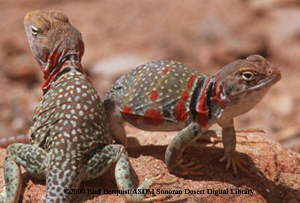Animal Fact Sheet: Collared Lizard |
Identifying Features The collared lizard (Crotaphytus collaris) is distinguished by the two black collars around its neck. Adult males have bright green scales as well as tan, olive, brown, bluish and yellow scales. Females are less colorful than the males. Both have whitish bellies and large heads. |
 |
Adaptations Collared lizards are one of only a few lizards that are able to run using only their hind legs. They are very fast with a stride up to three times their body length. They also do not lose their tail very easily, but if they do, it does not grow back. |
Habitat These lizards are found in a wide variety of habitats including sagebrush, desertscrub, pinyon-juniper and desert grasslands. They prefer the rocky areas of these habitats as well as areas with open vegetation. |
Range The collared lizard is found as far east as Missouri; through Utah, Nevada, southeastern California; throughout Arizona, and in parts of New Mexico. It is also found in northern Mexico including eastern Baja California. |
Wild Status Currently, they are not listed as threatened or endangered. |
Diet Not only do they eat insects such as grasshoppers and crickets, but they also eat other lizards, including other collared lizards! |
Predators Predators can include other lizards, birds such as roadrunners, as well as coyotes, house cats and other carnivorous mammals. |
Home These lizards prefer spending most of their time on and around rocky areas. These areas provide shelter from the sun and predators. |
Life Span The average life span is between 5-8 years. |
Size Collared lizards can reach a size of 10 inches in length with the males being larger than the females. |
Extra Fun-facts
|
 ©Copyright 2008, Arizona-Sonora Desert Museum
©Copyright 2008, Arizona-Sonora Desert Museum